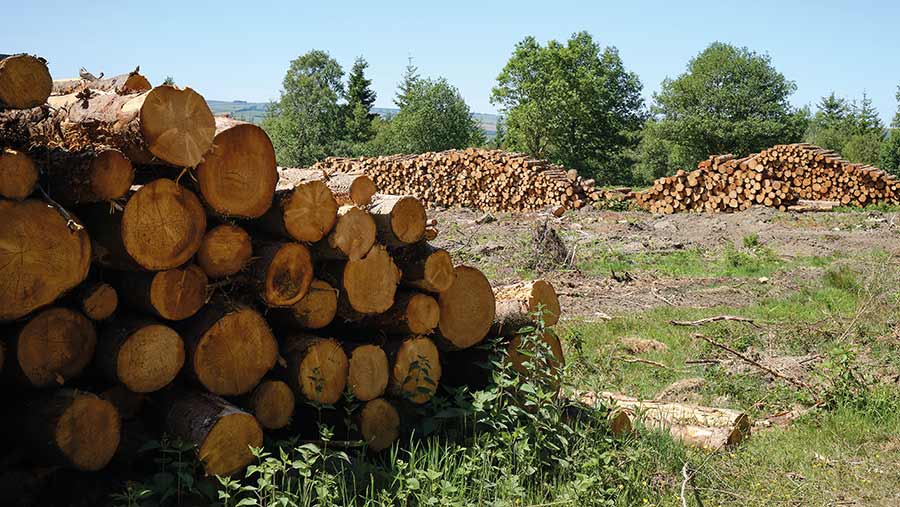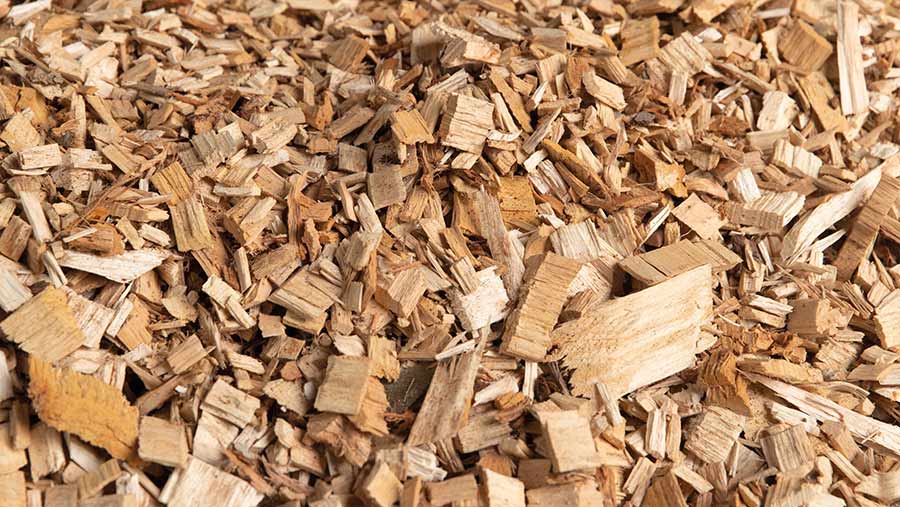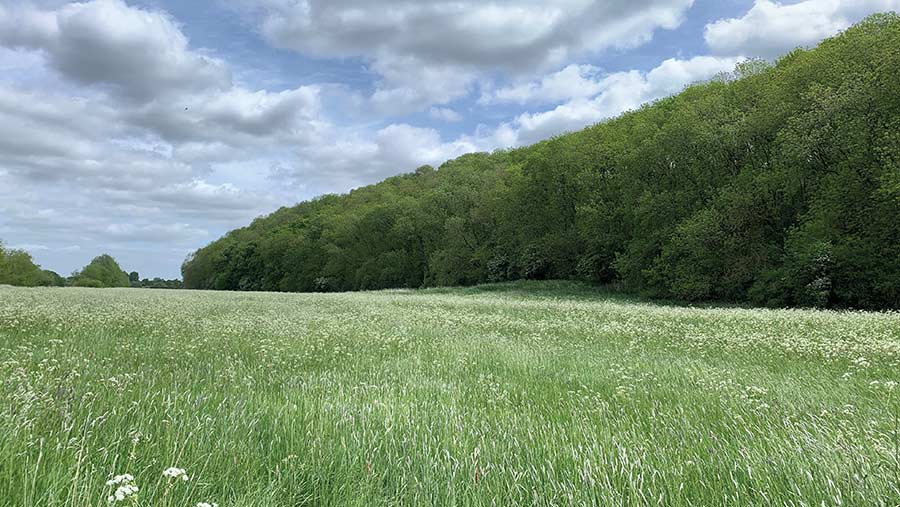A guide to the benefits of farm woodland management
 © Richard/Adobe Stock
© Richard/Adobe Stock Many farm woodlands hold income and/or enhancement potential. Farmers Weekly asked Savills forestry manger Marcus Taylor how to make more of this resource
Q. Why the focus on existing woodland?
Woodland creation is getting a lot of attention, but many established wooded areas on farms up and down the country are currently undermanaged, underperforming or even under threat if left to their own devices.
Despite comprising just 13% of the total UK land area, woodlands play a significant role in supporting the environment and wider climate.
See also: Woodland creation offer – what farmers need to know
Managed woodlands also provide a range of income potential far beyond simply timber production, which could diversify and support many farm businesses.
Historically, undermanagement may have been a result of the typically small scale of farm woodlands and previously low timber prices, making harvesting operations uneconomical.
However, times have changed. There has been a significant uplift in timber value and, despite some fluctuations, the lesser grade wood fuel and biomass markets remain in good shape.
This means even small operations could provide positive income.
Woodland cover also plays an important role in current and likely future rural policy. Understanding your woodland assets and how best to manage them to maximise their output for your farm is therefore increasingly important.
Q. Where do I start?
Investing in a Forestry Commission-approved woodland management plan (WMP) is recommended. There are substantial grants for this, paying a minimum £1,500 for 350ha and £30/ha up to and including 100ha.
Ideally, a forestry professional evaluates the woodland inventory, detailing exactly what’s there and in what condition.
The next and most important aspect is to work with the woodland owner and any other associated stakeholders to determine the objectives for the woodland to be achieved over the next 10 years.
In addition to the WMP, a five-year budgeted work programme is a good idea. It is one thing knowing what could or needs to be done, but another to know how and when it will be done, and the financial implications.
Time invested at this early planning stage will pay off in the long term and may help unlock some of the more creative income ideas.

© Tim Scrivener
Q. Are there any easy wins?
There are lots of wins for woodland management, but not all are easy. The benefits are wide and do not stop at the woodland edge, but carry on into the wider farm, community and even region.
Benefits can be grouped into three broad categories. Economic, environmental and social.
Economic refers to income-generation potential, such as from timber, rural jobs and assistance to reduce the nationally significant reliance on imported wood products.
Environmental covers the woodland ecosystem service benefits such as improved habitat, flood prevention, water purification, air and soil quality and also carbon sequestration, all of which offer income potential.
Social can refer to the health and wellbeing benefits that come from woodland interactions, which unmanaged woodlands typically do not permit.
Current policy encourages management for these wider benefits, but there are plenty of areas that could directly support the farm business – for example, glamping sites, forest schools, or even truffle production.
Q. What about upfront costs?
There will be upfront costs – for example, for the initial plan production or the lag time from Forestry Commission approval to eventual grant payment. As with all land use management, it is important to look at the long term.
This is why a budgeted work programme is important alongside the WMP to help forecast the costs and income and demonstrate the management viability.
A work programme may be focused on the woodland operations themselves, but there are plenty of additional opportunities for farm cost savings and risk reduction as a result of woodland management.
There is significant plant health concern, with ash dieback being a notable problem.
Active woodland management can allow proactive efforts to address liability issues relating to roadside or other high-risk areas, saving money on expensive reactive works, and upholding the landowner’s duty of care.
Q. Who should do the work – what can be done by farm staff and what needs a specialist?
Any tree felling or use of large machinery is best left to professionals with the right experience, qualifications and insurance.
This does not necessarily mean an external contractor cost, as most forestry outfits would offer to buy the timber standing.
If getting hands-on is your passion, then explore the Forestry Training Fund, which could cover the costs of forest skills courses such as chainsaw felling and many more.
There are still plenty of jobs that can be carried out by farm staff, such as young tree maintenance, mowing, spraying or even deer and squirrel management, all of which could be supported by grant funding.

© Savills
Q. What permissions or licences are needed?
A sensible rule of thumb is: if you are felling any number of your trees, apply for a licence and play it safe. The Forestry Commission has recently received increased powers to crack down on illegal felling in England.
If caught without a licence, landowners face unlimited fines and even prison sentences in extreme cases. Standalone licences will last five years, but may take 90 days from application to approval.
There are a few exemptions, but I would always err on the side of caution.
An additional benefit of an approved WMP is that felling licences will last 10 years, which reduces repeated applications, saving both time and money.
Q. What’s the best time to carry out work?
Technically, woodland operations can be carried out year round. Best practice, of course, is to avoid bird nesting season for any felling.
The planning stage will help weigh the specific site factors and owner priorities to determine the most appropriate timings and methods.
For most farm woodlands, the autumn usually offers the best conditions for operations, hitting the sweet spot of reasonably firm ground with died-back ground vegetation.
It’s handy when timber can be extracted across stubble fields in most cases.
There are always challenges, be it access restraints, weather or even game shooting, which pretty much rules out any major operations over the winter to avoid disturbance.
However, woodland management isn’t all about timber harvesting. There are lots of improvement works that can be spread out across the farming calendar.
Q. What’s the best way to sell timber – how do I know the value of what I have?
This is case specific and very dependent on the site – for example, the gradient, terrain, distance from the road, density of planting, age and type of tree.
With a small parcel of high-value, good-form oak it might make sense to pay a harvesting contractor and then sell the timber yourself at the roadside or direct to a mill for maximum return. However, for ease, a standing sale might be more suitable.
Having an agent involved in the early stages is recommended to make sure the harvesting agreement is fully thought through, including reinstatement terms.
These can be a major cause for dispute and a nasty surprise cost if things aren’t set out clearly from the start.
Finally, product price rates fluctuate. Saw log (the best-quality timber usually forming the bulk of the trunk from the base upwards) is significantly down in value compared with last year. However, wood fuel and biomass remain strong.
Timber price index
It’s worth keeping an eye on the market to ensure maximum return where possible. Look at the government’s six-monthly timber price index on the Forest Research website . The next update is due in May for the six months to March 2023.
Q. Sell it green or let it sit?
For nearly all timber sales it pays to sell it green. Water weight is your friend and on a £/t sale basis, the heavier it is, the better.
That said, certain products such as firewood and woodchip demand higher prices when dried, so there is no one-size-fits-all rule. It entirely depends on the operation and output.
Being able to repurpose a grain-drying shed to decrease the moisture content of firewood might be a good opportunity for farm woodland owners to increase product value.
Some specialist buyers still use the traditional measurement methods to value and buy timber, irrelevant of weight.
This is typically used for high-value products such as oak saw log and involves a mathematical calculation to estimate the saw log yield.
Q. What grants are there?
There are many grants for woodland owners, with the most enticing those focused on woodland creation. Grants are available to produce the plan, cover the costs of planting and support the maintenance. There is additional funding for public benefit such as access.
For the management of existing woodlands, grants are available in England under the Countryside Stewardship (CS) scheme in the form of the WMP creation grant.
There are also CS capital grants for supportive items such as fencing, access or timber extraction infrastructure, as well as woodland improvement grants, including deer and squirrel control.
The grant scheme for management is entering a period of change, but it would be very surprising if it is not renewed or adapted to support woodland management in the future.
Grants really do make a difference and are often the crucial factor between achieving all the woodland objectives or only taking the low-hanging fruit.
